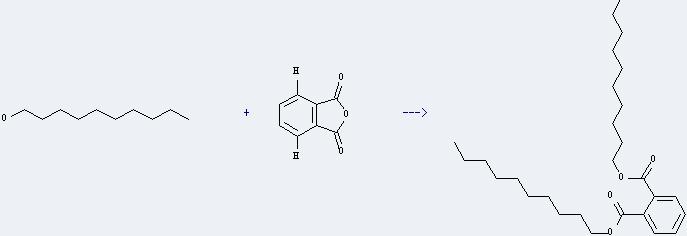-
Name
Didecyl phthalate
- EINECS 201-561-6
- CAS No. 84-77-5
- Article Data6
- CAS DataBase
- Density 0.966 g/cm3
- Solubility 0.33mg/L(24 oC)
- Melting Point 4 °C
- Formula C28H46O4
- Boiling Point 454.2 °C at 760 mmHg
- Molecular Weight 446.671
- Flash Point 243.7 °C
- Transport Information
- Appearance clear light yellow viscous liquid
- Safety 24/25
- Risk Codes
-
Molecular Structure
- Hazard Symbols
- Synonyms 1,2-Benzenedicarboxylicacid, didecyl ester (9CI);Phthalic acid, didecyl ester (6CI,7CI,8CI);Bis(n-decyl)phthalate;Decyl phthalate;Didecyl phthalate;
- PSA 52.60000
- LogP 8.28160
Didecyl phthalate Consensus Reports
Reported in EPA TSCA Inventory.
Didecyl phthalate Specification
The Didecyl phthalate with CAS registry number of 84-77-5 is also called 1,2-Benzenedicarboxylicacid,1,2-didecyl ester. The IUPAC name is didecyl benzene-1,2-dicarboxylate. Its EINECS registry number is 201-561-6. In addition, the molecular formula is C28H46O4 and the molecular weight is 446.66. It is a kind of clear light yellow viscous liquid and belongs to the classes of Organics; EstersAnalytical Standards; Alpha Sort; Analytical Standards; AromaticsVolatiles/ Semivolatiles; Chemical Class; D; DAlphabetic; DID - DINAnalytical Standards; Plasticizers.
Physical properties about this chemical are: (1)ACD/LogP: 11.20; (2)# of Rule of 5 Violations: 1; (3)ACD/LogD (pH 5.5): 11.2; (4)ACD/LogD (pH 7.4): 11.2; (5)ACD/BCF (pH 5.5): 1000000; (6)ACD/BCF (pH 7.4): 1000000; (7)ACD/KOC (pH 5.5): 10000000; (8)ACD/KOC (pH 7.4): 10000000; (9)#H bond acceptors: 4; (10)#Freely Rotating Bonds: 22; (11)Polar Surface Area: 52.6 Å2; (12)Index of Refraction: 1.487; (13)Molar Refractivity: 133.19 cm3; (14)Molar Volume: 462.3 cm3; (15)Polarizability: 52.8 ×10-24cm3; (16)Surface Tension: 36 dyne/cm; (17)Density: 0.966 g/cm3; (18)Flash Point: 243.7 °C; (19)Enthalpy of Vaporization: 71.38 kJ/mol; (20)Boiling Point: 454.2 °C at 760 mmHg; (21)Vapour Pressure: 1.94E-08 mmHg at 25°C.
Uses and preparation of Didecyl phthalate: it can be used as plasticizer of vinyl resins and cellulose resins, and it also can be used as gas chromatography stationary phase. In addition, it can be prepared by phthalic acid anhydride and decan-1-ol. This reaction is a kind of esterification reaction and will need reagent PTSA/activated carbon. The reaction time is 55 seconds and the yield is about 90%.

When you are using this chemical, please be cautious about it as the following:
During using it, you should avoid contact with skin and eyes.
You can still convert the following datas into molecular structure:
(1)SMILES: O=C(OCCCCCCCCCC)c1ccccc1C(=O)OCCCCCCCCCC
(2)InChI: InChI=1/C28H46O4/c1-3-5-7-9-11-13-15-19-23-31-27(29)25-21-17-18-22-26(25)28(30)32-24-20-16-14-12-10-8-6-4-2/h17-18,21-22H,3-16,19-20,23-24H2,1-2H3
(3)InChIKey: PGIBJVOPLXHHGS-UHFFFAOYAK
The toxicity data is as follows:
| Organism | Test Type | Route | Reported Dose (Normalized Dose) | Effect | Source |
|---|---|---|---|---|---|
| mouse | LDLo | intraperitoneal | 2233mg/kg (2233mg/kg) | SENSE ORGANS AND SPECIAL SENSES: PTOSIS: EYE BEHAVIORAL: SOMNOLENCE (GENERAL DEPRESSED ACTIVITY) | Journal of Pharmaceutical Sciences. Vol. 56, Pg. 1446, 1967. |
| rabbit | LD50 | skin | 16800uL/kg (16.8mL/kg) | American Industrial Hygiene Association Journal. Vol. 23, Pg. 95, 1962. | |
| rat | LD50 | oral | > 64mL/kg (64mL/kg) | American Industrial Hygiene Association Journal. Vol. 23, Pg. 95, 1962. |
About|Contact|Cas|Product Name|Molecular|Country|Encyclopedia
Message|New Cas|MSDS|Service|Advertisement|CAS DataBase|Article Data|Manufacturers | Chemical Catalog
©2008 LookChem.com,License: ICP
NO.:Zhejiang16009103
complaints:service@lookchem.com Desktop View